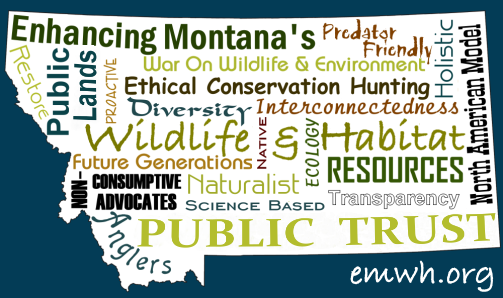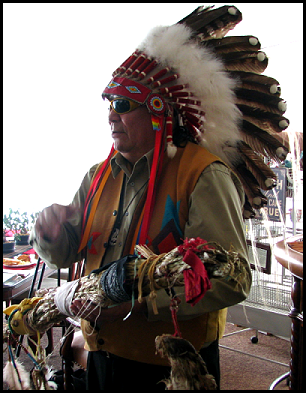IBMP APHIS / MT DOL Bison Hunting Tool
Using Montana and Tribal
Hunters as the APHIS / DOL
Brucellosis Eradication Gun,
to deflect eradication attention from themselves.
(I am a hunter that advocates
for ethical, Fair Chase hunting and the
North American Model of Wildlife Conservation. I also
respect Native American Nations sovereignty)
Help put a stop to the brucellosis politics! Please Petition for the peer reviewed science of wildlife management for our bison and elk. |
 |
| "As a result, the federal government and State of Montana agreed to an Interagency Bison Management Plan (lBMP) that established guidelines for managing the risk of brucellosis transmission from bison to cattle by implementing hazing, test and-slaughter, hunting, and other actions near the park boundary (U.S. Department of the Interior [USDI] and U.S. Department ofAgriculture [USDA] 2000a)."- IBMP APHIS and the Montana Department of Livestock have sought to stall the restoration of wild bison onto Montana public lands. All bison entering have been shot, captured for studies, slaughtered at the boundary under the guise of hunting, or hazed back into Yellowstone National Park. All this done under the exaggerated statement that bison pose a disease threat to humans and livestock. The truth is that APHIS has an eradication of brucellosis agenda in widlife. Montana's Department of Livestock is more than willing to receive the APHIS eradication of brucellosis money (federal taxpayer dollars) to market their beef as Brucellosis Class Free and remove forage competing ungulates from the landscape MCA 81-2-120. The science being produced today reports that the transmission risk from wild YNP bison to cattle is 0.0-0.3% (the 0.3% being an academic safety net), elk representing 99.7%-100% of the risk (bison science at the end of page). Below are documents dealing with the APHIS / DOL shift from outright slaughter, which received the public's outrage and a public relations black eye, to seeking less obvious ways to eradicate wild bison which test positive for exposure to brucellosis - one tool being to use hunters to slaughter bison exiting Yellowstone National Park, rather than a true "fair chase" hunt, as other wildlife in Montana are required to receive. "Any hunt configuration approved would have to minimize bad publicity such as that generated by the public hunt authorized by the 1985 Montana Legislature and recinded by the 1991 Montana Legislature." "87-2-730. (Effective March
1, 2014) Special wild buffalo license -- regulation. (1) The public
hunting of wild buffalo or bison that have been designated as a
species in need of disease control under 81-2-120 is permitted only
when authorized by the department of livestock
under the provisions set forth in 81-2-120." The northern portion of the Yellowstone National Park, the Beattie Gulch area, is a bottleneck of very limited land, near a residential and commercial area. Hundreds of bison have been killed in this small area, just after they step out of the Park. In addition to hundreds of gut piles, the bison gestation is nearing completion, with advanced development of bison fetuses, which also are part of the gut piles. This is a disease issue, as well as a major attractant for scavengers and predators. "In 2000, the federal government and the State of Montana signed an agreement that established guidelines for cooperatively managing the risk of brucellosis transmission from bison to cattle—primarily by excluding bison from areas used by cattle. This Interagency Bison Management Plan (IBMP) also emphasized preserving the bison population as a natural component of the ecosystem and allowing some bison to occupy winter ranges on public lands in Montana. Five agencies were originally responsible for implementing the plan—the National Park Service, Animal and Plant Health Inspection Service, U.S. Forest Service, Montana Department of Livestock, and Montana Fish, Wildlife & Parks. The Confederated Salish and Kootenai Tribes of the Flathead Nation, Nez Perce Tribe, and InterTribal Buffalo Council were added as members in 2009 due to their treaty hunting rights on some unoccupied federal lands in southwestern Montana and their commitment to restoring bison. " - YNP |
|
|
|
Mont.
bison harvest a ‘shameful disgrace’ -
Todd Wilkinson, Part 6 of a series on
wildlife disease management in the Greater Yellowstone Ecosystem
|
Timeline 2003 - SB 395 - Sport hunting of bison as management tool. The proponents of SB 395 claimed bison hunts would not be a repeat of the slaughter "hunt" in 1985, recinded in 1991. Gov. Judy Martz supported the bill. "It's another tool that we have to be able to control the number of bison that are in the park," she said. There were no provisions in SB 395 to insure a "fair-chase" hunt. DOL was put in charge of determining where, when, and which animals would be hunted. Montana Wildlife Federation officially opposed SB 395. They claimed that in order to support a bison hunt in Montana, authority for bison management must be transferred to FWP, that all references to disease management must be separated from a hunt, and that bison management in the Yellowstone area must be re-evaluated to insure that a fair-chase hunt is possible. 2004 - Draft EA for Bison Hunt Impacts 2004
- Final Bison Hunting Decision Notice 2008-2009 - A Concept Paper For A New Direction For the Bovine Brucellosis Program - APHIS VS 2009 - The Confederated Salish and Kootenai Tribes of the Flathead Nation, Nez Perce Tribe, and InterTribal Buffalo Council were added as members to the IBMP 2013 - Tribal Slaughter North Boundary of YNP, Gardiner 2014 - Tribal Slaughter North Boundary of YNP, Gardiner USAHA (United States Animal Health Association) 2005 Brucellosis in the Greater Yellowstone Area - "APHIS/VS agrees with the actions and steps included in this resolution. VS is providing resources for brucellosis surveillance and control activities. Eradication activities cannot occur until the other agencies agree on a disease eradication plan. To assure collaboration among the relevant agencies, VS is working and will continue to work with these agencies to develop MOU’s and agreements on a plan of action that includes eradication of brucellosis from the GYA. VS is willing and able to take the lead once a brucellosis eradication plan has been agreed to between the agencies." A Concept Paper For A New Direction For the Bovine Brucellosis Program - APHIS VS 2009, "The goal of the program is to eradicate brucellosis from the United States." "Despite cooperative Federal-State-industry efforts to eradicate this disease and the significant progress we have made, final eradication will not become possible unless the country adopts new strategies to address current challenges. Eradication depends on finding the last remaining brucellosis-reactor animal, the last remaining brucellosis-affected herd, and eliminating the disease from wildlife reservoirs. All potential risks for exposure and transmission of brucellosis from infected wildlife populations must be mitigated and eliminated as well. Currently, the last known reservoir of disease is the wildlife populations in the GYA. A new direction is needed that will allow VS and States to apply limited resources effectively and efficiently to this unique disease risk."(pg. 2) Science - Bison Brucellosis Risk
The science being produced today reports that the transmission risk from wild YNP bison to cattle is 0.0-0.3% (the 0.3% being an academic safety net), elk representing 99.7%-100% of the risk. A Risk Analysis of Brucella abortus Transmission Among Bison, Elk, and Cattle in the Northern Greater Yellowstone Area (2010), 0.0-0.3%, which DoL's Dr. Marty Zaluski was one of 7 authors on. - page 41 Brucellosis Science Review Workshop Panelists Report 2013."To date, no documented transmission of brucellosis from Yellowstone bison to cattle has occurred." "The organizers' intent was that conclusions and recommendations from the panel would be considered by the National Park Service in decision-making on the potential implementation of future vaccination programs, and that the workshop report also would inform short- and long-term adaptive management decisions on and strategies for disease management activities associated with the IBMP." |
Documents MCA
87-2-730 Bison Hunting in Montana Draft EA for Bison Hunt Impacts Final
Bison Hunting Decision Notice What has occurred the last two winters is not fair chase; is in a small bottle neck, just as the bison exit the YNP; gut piles and unborn pregnancies from around 200 bison are on the landscape, right next to a residential and commercial area presenting a disease and scavenger threat; hunting from the road has occurred. IBMP
2008-2009 Annual Report "Continue evaluating
opportunities and constraints for (l) transferring "surplus"
bison to quarantine facilities for further surveillance and eventual
release onto suitable restoration sites or to terminal destinations
on tribal or other lands for periodic harvest for food or ceremonial
pnrposes, and (2) adjusting conservation zones to increase
state and treaty hunting opportunities in habitat outside the
park." 2013 Beattie Gulch Slaughter PDF - Bonnie Lynn, PDF and maps created by Kathryn QannaYahu
|
Your Advertisement Here |
Site designed and maintained by Kathryn QannaYahu





